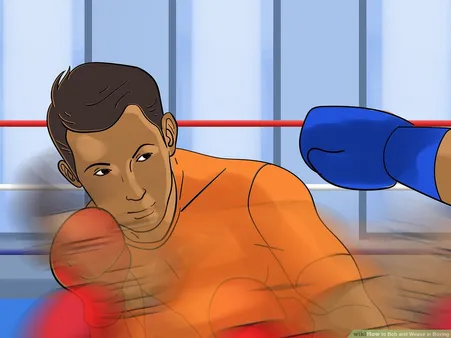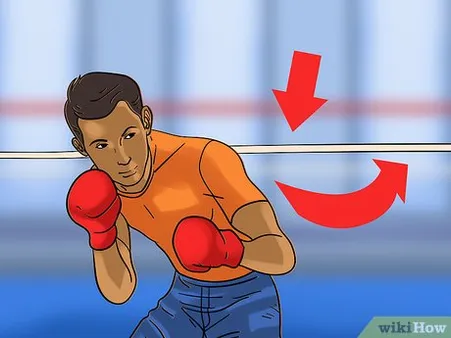Table of Contents
In the realm of boxing, mastering defensive techniques is paramount, and the bob and weave stands as a cornerstone of evasion and counterattacking brilliance. This elusive maneuver, when executed with precision, allows fighters to effortlessly slip punches while simultaneously creating openings for their own strikes. If you're seeking to elevate your boxing prowess, understanding How to do a bob and weave is indispensable. At Kizworld, we'll guide you through the intricacies of this technique, breaking down its benefits, providing step-by-step instructions, and offering tips to help you master this essential skill. Prepare to enhance your ringcraft, embrace the art of evasion, and emerge as a formidable force in the squared circle.
How to Do a Bob and Weave: A Step-by-step Guide to Master the Art of Evasion
I. The Fundamentals of Bobbing and Weaving: Enhancing Defensive Capabilities in Boxing
The Fundamentals of Bobbing and Weaving: Enhancing Defensive Capabilities in Boxing
Bobbing and weaving are fundamental defensive techniques in boxing that enable fighters to evade punches while simultaneously creating opportunities for counterattacks. This dynamic movement, characterized by dipping down and shifting sideways, allows boxers to slip past incoming strikes and position themselves for effective counters.
To master the art of bobbing and weaving, fighters must possess excellent footwork, timing, and balance. By bending their knees and lowering their center of gravity, they can swiftly drop down to avoid punches aimed at the head or body. Simultaneously, they shift their weight from one foot to the other, creating a fluid motion that makes them difficult to hit.
Benefits of Bobbing and Weaving
- Enhanced Defense: Bobbing and weaving minimizes the chances of getting hit by an opponent's punches, reducing the risk of facial injuries and knockouts.
- Improved Counterattacking Opportunities: By creating openings in the opponent's defense, bobbing and weaving allows fighters to land quick and powerful counterpunches.
- Increased Ring Generalship: Mastering bobbing and weaving gives boxers greater control over the pace and rhythm of the fight, allowing them to dictate the terms of engagement.
- Improved Footwork and Coordination: The constant movement involved in bobbing and weaving enhances a boxer's footwork and coordination, making them more agile and responsive in the ring.
How to Do a Bob and Weave
- Stance and Positioning: Stand with your feet shoulder-width apart, knees slightly bent, and hands up in a guard position. Keep your weight balanced evenly on both feet.
- Dip and Shift: When an opponent throws a punch, quickly dip down and shift your weight to the opposite foot. Aim to lower your head below the level of the punch while keeping your eyes on your opponent.
- Recover and Counter: As you complete the bob and weave, immediately recover to your original stance and be ready to counterattack with a punch of your own. The timing and accuracy of your counterpunch are crucial for its effectiveness.
Tips for Effective Bobbing and Weaving
- Practice Regularly: Mastering bobbing and weaving requires consistent practice. Incorporate the technique into your shadowboxing, mitt work, and sparring sessions to develop muscle memory and improve your timing.
- Vary Your Movements: Don't become predictable in your bobbing and weaving patterns. Mix up the timing, direction, and depth of your movements to keep your opponent guessing.
- Stay Balanced: Maintaining balance is essential for executing effective bobbing and weaving. Keep your weight distributed evenly on both feet and avoid leaning too far forward or backward.
- Be Patient: Bobbing and weaving is a defensive technique that requires patience. Don't rush your movements or try to force a counterattack. Instead, wait for the right moment to strike.
Common Mistakes to Avoid
- Dropping Your Hands: Never drop your hands when bobbing and weaving. Keep them up to protect your face and head at all times.
- Overcommitting to the Bob: Don't dip too low when bobbing. This can leave you vulnerable to uppercuts or body shots.
- telegraphing Your Movements: Avoid telegraphing your bob and weave by keeping your movements smooth and fluid. Don't make it obvious when you're about to dip down.
- Neglecting Footwork: Bobbing and weaving is not just about head movement. Proper footwork is crucial for creating angles and positioning yourself for counterattacks.
In conclusion, the bob and weave is a key defensive technique in boxing that helps fighters evade punches and create opportunities for counterattacks. By mastering this technique, boxers can significantly improve their defensive capabilities and increase their chances of victory in the ring.
II. Mastering the Bob and Weave: Techniques for Evading Punches and Outmaneuvering Opponents
Mastering the Bob and Weave: Techniques for Evading Punches and Outmaneuvering Opponents
To master the bob and weave, it's crucial to understand the fundamental techniques that make it an effective defensive maneuver. Here are some key elements to focus on:
- Footwork: Maintaining proper footwork is essential for executing the bob and weave effectively. Keep your feet shoulder-width apart, with your knees slightly bent and your weight evenly distributed. This stance allows you to move quickly and change directions easily.
- Head Movement: The bob and weave involves moving your head in unpredictable patterns to make it difficult for your opponent to land clean punches. Bobbing means ducking your head down to avoid punches aimed at your face, while weaving involves moving your head from side to side to evade hooks and uppercuts.
- Body Movement: In addition to head movement, you should also incorporate body movement into your bob and weave. This means shifting your weight and torso to create angles that make it harder for your opponent to hit you. By moving your body in conjunction with your head, you can create a more comprehensive defense.
- Timing and Reaction: The bob and weave is all about timing and reaction. You need to be able to anticipate your opponent's punches and react quickly to avoid them. This requires practice and developing a sense of rhythm in your movements.
Here are some additional tips for mastering the bob and weave:
- Start Slowly: When practicing the bob and weave, start slowly and gradually increase your speed as you become more comfortable with the technique.
- Practice with a Partner: To improve your timing and reaction, practice the bob and weave with a partner who can throw punches at you. This will help you get used to the feeling of being under pressure and will teach you how to react to different types of punches.
- Use the Bob and Weave in Combination with Other Defensive Techniques: The bob and weave is just one of many defensive techniques that boxers use. To be a truly effective defender, you need to be able to use a variety of techniques, such as slipping, parrying, and blocking, to protect yourself from your opponent's punches.
By following these tips and practicing regularly, you can master the bob and weave and become a more effective boxer.
Here are some common mistakes to avoid when bobbing and weaving:
- Dropping Your Hands: When you bob and weave, it's important to keep your hands up to protect your face and body. Dropping your hands leaves you open to punches and can lead to getting hit.
- Overcommitting: Don't bob and weave too much or for too long. If you overcommit to the technique, you can leave yourself vulnerable to counterattacks. Use the bob and weave sparingly and only when necessary.
- Not Moving Your Feet: Footwork is essential for the bob and weave. If you don't move your feet, you'll be an easy target for your opponent. Keep your feet moving and change your stance frequently to make it harder for your opponent to hit you.
- Not Anticipating Your Opponent's Punches: The bob and weave is most effective when you can anticipate your opponent's punches. Pay attention to your opponent's body language and movements to get a sense of what they're going to throw. This will help you react more quickly and effectively to their punches.
By avoiding these mistakes, you can improve your bob and weave technique and become a more effective boxer.
The bob and weave is a fundamental boxing technique that can help you evade punches and create opportunities for counterattacks. By mastering the techniques and avoiding common mistakes, you can become a more effective boxer and improve your chances of winning fights.
Here are some related articles that you may find helpful:
- How to Do a Jab
- How to Do a Cross
- How to Do a Hook
- How to Do an Uppercut
- How to Do a Slip
- How to Do a Clinch
III. Applying the Bob and Weave in Real-World Boxing Situations
Applying the Bob and Weave in Real-World Boxing Situations
The bob and weave technique is a fundamental skill in boxing that allows fighters to evade punches and create opportunities for counterattacks. It is a versatile move that can be used in various situations, both offensively and defensively. Here are some examples of how the bob and weave can be applied in real-world boxing matches:
- Evading Punches: The bob and weave is an effective way to avoid an opponent's punches. By quickly moving the head and upper body down and to the side, a fighter can make it difficult for the opponent to land clean shots. This technique is particularly useful against straight punches, such as jabs and crosses.
- Creating Counterattacking Opportunities: The bob and weave can also be used to create opportunities for counterattacks. By moving the head and upper body out of the way of an opponent's punch, a fighter can quickly come back with their own punches. This can be especially effective against power punches, such as hooks and uppercuts.
- Setting Up Combinations: The bob and weave can be used to set up combinations of punches. By moving the head and upper body out of the way of an opponent's punch, a fighter can create an opening for a follow-up punch. This can be a very effective way to score points and damage an opponent.
- Breaking an Opponent's Rhythm: The bob and weave can also be used to break an opponent's rhythm. By constantly moving the head and upper body, a fighter can make it difficult for the opponent to find their range and land clean punches. This can frustrate the opponent and lead to mistakes.
The bob and weave is a versatile and effective technique that can be used in a variety of situations in boxing. By mastering this technique, fighters can improve their defensive skills, create opportunities for counterattacks, and set up combinations of punches. This can lead to greater success in the ring.
Here are some additional tips for using the bob and weave effectively in boxing:
- Keep your feet shoulder-width apart and your knees slightly bent. This will give you a stable base and allow you to move quickly and easily.
- Bend your elbows and keep your hands up near your face. This will help you to protect yourself from punches and be ready to counterattack.
- Move your head and upper body in a fluid motion. Don't be stiff or jerky, as this will make it easier for your opponent to hit you.
- Be unpredictable. Don't always bob and weave in the same way. Mix it up and keep your opponent guessing.
- Practice the bob and weave regularly. The more you practice, the better you will become at using it effectively in a fight.
With practice, you can master the bob and weave and use it to become a more successful boxer.
Here are some related articles that you may find helpful:
- How to Do a Bob and Weave
- The Benefits of Doing a Bob and Weave
- Common Mistakes to Avoid When Bobbing and Weaving
IV. Training Regimens for Developing Effective Bobbing and Weaving Skills
Training Regimens for Developing Effective Bobbing and Weaving Skills
To master the art of bobbing and weaving, a dedicated training regimen is essential. Here are some key elements to incorporate into your routine:
- Footwork Drills: Begin with footwork drills to enhance your agility and coordination. Practice quick side-to-side movements, forward and backward steps, and pivots.
- Shadowboxing: Shadowboxing is an excellent way to refine your bobbing and weaving technique without an opponent. Focus on maintaining a balanced stance, keeping your hands up, and executing smooth, controlled movements.
As you progress, gradually increase the intensity and complexity of your training:
- Partner Drills: Work with a partner to practice controlled bobbing and weaving. Have your partner throw slow, controlled punches while you practice slipping and countering.
- Speed Bag Work: The speed bag is a great tool for developing hand-eye coordination and reaction time. Practice bobbing and weaving while striking the bag, focusing on maintaining a steady rhythm.
To further enhance your bobbing and weaving skills, consider these additional tips:
- Stay Relaxed: Maintaining a relaxed stance is crucial for effective bobbing and weaving. Avoid tensing up, as this will hinder your ability to move quickly and smoothly.
- Keep Your Eyes on Your Opponent: Always maintain eye contact with your opponent to anticipate their punches and react accordingly.
By consistently implementing these training methods, you can develop the bobbing and weaving skills necessary to become a formidable opponent in the ring.
Related Posts:
- How to Do a Handstand: A Step-by-Step Guide for Beginners
- The Benefits of Gymnastics for Kids: Building Strength, Flexibility, and Confidence
- The Best Gymnastics Equipment for Home Use: Creating a Safe and Fun Training Space
V. Conclusion
Mastering the bob and weave is a journey that requires dedication, practice, and a keen eye for your opponent's movements. As you continue to hone your skills, you'll find that this technique becomes an integral part of your boxing arsenal, helping you evade punches, create opportunities, and ultimately achieve victory in the ring. Remember, the bob and weave is not just a defensive move; it's an offensive weapon that can turn the tide of a fight in an instant. So, embrace the challenge, practice diligently, and unleash the power of the bob and weave to become a formidable force in the world of boxing.